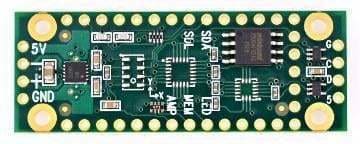Teensy Prop Shield - LC - Low Cost (no Motion Sensors)
Teensy Prop Shield - LC - Low Cost (no Motion Sensors) is backordered and will ship as soon as it is back in stock.
Couldn't load pickup availability
DESCRIPTION
This low-cost Prop Shield is meant for making light and sound effects on small handheld props and wearable costumes.
- Audio Amplifier- Clear quality audio output to a small speaker.
- Fast LED Driver- Drive APA102 / Dotstar LEDs for colourful lighting with rapid response.
- Flash Memory- 8Mbyte storage for images, sound clips, and data logging.
This shield features a 2-watt audio amp, high speed 5V buffers for driving APA102 LEDs, and an 8 Mbyte flash memory for images, sound clips, or data logging. It's approximately the size of a Teensy, just slightly longer to allow space for mounting holes and connections for power, speaker, and LEDs
FEATURES
Audio Amplifier
The Prop Shield has a 2-watt audio amplifier, capable of driving 4 or 8-ohm speakers. 4-ohm car speakers work very well for permanent installations where louder sound levels are needed.

By default, the amplifier remains in a low power mode. You must drive pin 5 high to turn on the amplifier. It typically needs 8 milliseconds to wake up.
void setup() { pinMode(5, OUTPUT); digitalWrite(5, HIGH); // turn on the amplifier delay(10); // allow time to wake up
With Teensy 3.2, the Teensy Audio Library can be used to create sounds. Nearly all the audio library examples are designed for the Audio Shield. To adapt them for the Prop Shield, replace "i2s1" with "dac1" in the Design Tool, or AudioOutputI2S with AudioOutputAnalog in the Arduino code. Then delete the SGTL5000 object and any code which uses it.
By default, the audio library will create a 1.2Vp-p signal at the DAC pin, which is a comfortable volume level for listening in a quiet room, but not nearly the amplifier's full power. To get louder output, set the dac1 object to use EXTERNAL reference. Doing this before powering up the amp will avoid a loud click.
AudioMemory(20); dac1.analogReference(EXTERNAL); // much louder! delay(50); // time for DAC voltage stable pinMode(5, OUTPUT); digitalWrite(5, HIGH); // turn on the amplifier delay(10); // allow time to wake up
For fine volume control, use a mixer object just before the DAC output in your audio design, where your code can control the mixer gain to change the volume.
On Teensy LC, the Talkie library can be used for simple voice synthesis.
Fast LED Driver
The Prop Shield has 5V buffers meant to send data to Dotstar or APA102 type addressable LEDs.
Normally the FastLED library is used to control these types of LEDs. The Prop Shield uses pin 7 to control access to the LEDs. If no other SPI chips are used, it can simply be set high in setup().
#include <FastLED.h> #define NUM_LEDS 144 CRGB leds[NUM_LEDS]; void setup() { delay(2000); // sanity check delay FastLED.addLeds<APA102, BGR>(leds, NUM_LEDS); pinMode(7, OUTPUT); digitalWrite(7, HIGH); // enable access to LEDs } void loop() { // Move a single white led for(int n = 0; n < NUM_LEDS; n++) { leds[n] = CRGB::White; FastLED.show(); delay(8); leds[n] = CRGB::Black; } }
When other SPI communication is used, pin 7 must be HIGH to allow LED access and LOW to prevent other SPI chips from interfering with the LEDs. The SPI transactions functions should also be used. You will need to include SPI.h to have access to these SPI functions.
// beginTransaction prevents SPI bus conflicts SPI.beginTransaction(SPISettings(24000000, MSBFIRST, SPI_MODE0)); digitalWrite(7, HIGH); // enable access to LEDs FastLED.show(); digitalWrite(7, LOW); SPI.endTransaction(); // allow other libs to use SPI again
Flash Memory
The Prop Shield has an 8 Mbyte flash memory, meant to storing
sound clips, images, logging data, or other uses.
 |
The SerialFlash library is used to access this memory.
Use TeensyTransfer to copy files to the flash chip without an SD card.
RESOURCES
- LM48310- 2.6W Mono Class D Audio Power Amplifier
- W25Q64FV- 64 Mbit (8 Mbyte) Serial Flash Memory
- SN74AHCT1G08- Single 2-Input AND Gate







